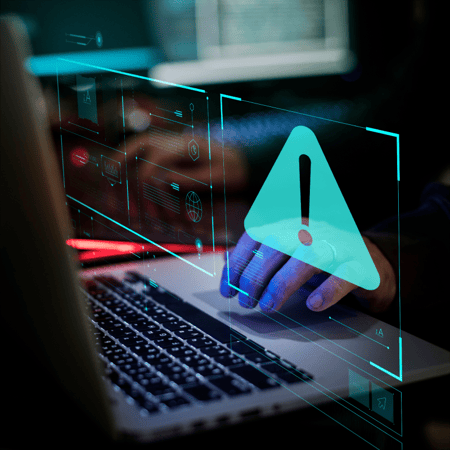According to a SonicWall Cyber Threat Report, the world has seen a whopping 62% increase in ransomware attacks. The Accellion Supply Chain Attack, and Colonial Pipeline’s DarkSide Intrusion that resulted in millions of dollars in losses and damages, are just two of the most infamous attacks of their kind.
It’s imperative that businesses treat cyber security as a priority, given their ever-increasing dependence on technology.

Put simply, a cyber security threat refers to any possibility of a malicious attempt to steal data or cause damage/disruption to computer systems, networks, or assets, mostly via unauthorized access. Cyber threats can range from ransomware and viruses, phishing, insider threats to data theft, and they have the power to halt operations and even shut down organizations. Understanding how to protect your systems and having effective backup/remediation plans are the best ways to mitigate cyber threats and minimize the damages should you (or your company) ever be victims of cyberattacks.
Here are a few best practices when it comes to protecting your crucial systems, software, and precious data.
It is vital that businesses keep all of their assets as up-to-date as possible, at least from a software/applications standpoint, if not in terms of hardware. Most software updates pertain to security patches.
The Equifax data breach is a relevant example of how regular system updates could have avoided cyber adversity.
Had Equifax—as one of the three largest consumer credit reporting agencies— stayed vigilant and updated their systems, hordes of personal information about hundreds of millions of people across the US, UK and Canada wouldn’t have leaked.
The cybersecurity gaps that allowed the breach to occur could have been fixed had the company updated its software two months prior. Most attacks occur on massive systems such as browsers and data storage centers. As such, it is imperative that they are regularly updated.
In addition to bridging security gaps, updates introduce new features and enhance old ones, improving system/process stability. While updating large systems can be bothersome and hinder operations in the short term, it is critical for the long run.
Phishing is arguably as old as the internet itself. It has evolved from targeting vulnerable individuals to going after large organizations. Unknown or suspicious links in emails or browsers are highly likely to be Trojan horses housing viruses or malware. Such malicious code can even be built into a website that redirects users to a secondary site that downloads malware to their device.
Today’s phishing attacks have become even more sophisticated as most attacks rely heavily on social engineering, which involves manipulating people into making decisions or revealing information such as social security numbers or passwords.
Malware like keyloggers may lay dormant in systems for months or even years before the attack is enacted. And by then, it would be almost impossible to track down the source. To stay protected, it’s ideal to run system tests regularly or after clicking suspicious links.
Keep an eye out for suspicious and abrupt issues such as webcams not working or batteries heating up.
Even as cyber threats continue to evolve, traditional security tools and measures can still go a long way in securing enterprises.
Firewalls and password protection are the first line of defense in protecting a computer system.

Companies must ensure that employees use strong passwords for any administrative access, especially those guarding crucial data. For applications and access to systems and devices, the Multifactor Authentication (MFA) security feature should be used.
Another excellent practice is to register at least two devices for multifactor authentication so that data may be remotely erased and the other device can be used to authenticate if one is lost. It may still not be enough to safeguard against phishing attacks directing the user to a fake webpage to enter credentials, hence all employees should be trained on social engineering tactics so they recognize and avoid falling prey to them.
Crucial passwords should be memorized, if possible, as third-party password storage sites are known to be notoriously unsafe. As the saying goes, exposed passwords are more dangerous than a potential cyber threat. Should an intrusion be detected, most networks can automatically protect themselves.
However, it is much harder to identify and protect against an unauthorized person who entered the system with a password.
No matter how large or small an organization is, an unstable or exposed network threatens its system’s safety and clients’ privacy.
A significant example is the Citigroup Security Breach in 2011 that impacted thousands of its customers in the US. A well-guarded network is critical in any cybersecurity plan. Reliable and secure network connections are essential in attaining a sound cybersecurity posture.
To this end, Network security infrastructure provides several layers of protection that even prevent Man-in-the-middle (MiM) attacks by breaking down data into several distinct parts, encrypting those parts, and transmitting them through independent paths.
The approach thereby prevents undesirable activity like keylogging.
The damage and theft of intellectual property are also a massive by-product of faulty network security systems. If an attacker can infiltrate your system and steal plans, ideas, or blueprints, the company can miss implementing new designs and products.
File sharing is another phenomenon that leaves a network open to attack. The more people have unfettered access to sensitive files, the more likely it is that that file will go public or be seen by someone who isn’t supposed to see it.
A virus could be downloaded on an employee workstation through a phishing scheme, and then that malware uploads onto the shared file when the employee accesses it. When engaging in file sharing, it is best to find a service that has end-to-end encryption. This will better protect hackers from accessing your files and keep the host of the service from viewing the data.
Checking permission settings and regularly running audits to know who has access to sensitive files are a few tips that prevent unauthorized access.

Firewalls are indispensable in defending against external cybersecurity threats. They block spyware, and to a degree, block spam messages and fend off hackers. Investing in a good firewall and updating it regularly is, therefore, an absolute necessity for any business. However, Business-grade firewalls may cost companies more in terms of providing better protection from intruders.
Storing the copy of the data separately on a different medium is critical against primary data loss or corruption. It can be as simple as leveraging an external drive or USB stick or something more substantial, such as a disk storage system or dedicated cloud storage. The alternate medium can be in the same location as the primary data or at a remote location.

The purpose of backing up data is to have a reliable copy in case the primary data is compromised. This practice is the safest bet against any number of problems, ranging from accidental data loss or corruption to software failure due to cyber-attacks.
A test of the backup solution should be in place that ensures that the most critical data is restored in a recovery environment where its functionality can be verified.
Given the sheer volume and sophistication of attacks, it is always challenging to prevent or fight off an infiltration. However, should a malware or ransomware attack successfully damage the main network or lock the administration out, having reliable backups can prevent data loss or the need to pay a ransom, potentially saving organizations.
A cross-functional team involving professionals from IT, cybersecurity, operations and even the top management is an essential prerequisite for sound protection against cyber attacks. Every organizational stakeholder should work in cohesion for attaining and upholding organization-wide cybersecurity assurance.
Multi-factor authentication is a powerful feature to prevent unauthorized users from accessing sensitive data. For the most secure user sign-ins, companies can use a combination of user authentication methods such as biometrics, SMS/text messages, emails, and security questions. It is also a good practice to leverage extra layers of protection, like text verification, email verification, or time-based security codes.

A joint study conducted by Stanford University Professor Jeff Hancock and the security firm, Tessian, discovered that around 88% of cybersecurity incidents are due to mistakes made by employees/users. Even the best security systems would be ineffective should there be security lapses from the employees’ side.
It is therefore essential that everyone in any organization fully understand cybersecurity awareness and best practices.
They ought to be trained to recognize signs of social engineering, phishing attempts, etc., and be receptive to regular system updates. Although cybersecurity training may appear to be a tedious affair and a waste of resources, it will save organizations from irreparable harm down the line.
Year after year, cyberattacks and threats continue to evolve and diversify as the enterprise world steers more towards cloud adoption, remote working, and BYOD practices, to name a few.
In today’s day and age where the black hats have become more organized than ever—to such an extent that they are even offering ransomware-as-a-service—protecting your business from cyber threats calls for cybersecurity best practices, be it securing devices and networks, monitoring equipment and system, backing up data, encrypting crucial files and training employees in following and adhering to cybersecurity protocols and policies. The role of cybersecurity consultants in this regard is quintessential.

Novacommand can help detect threats by inspecting and analyzing the network traffic. The information about the network traffic (metadata) will be correlated and analyzed as well.
By doing this, threats can be detected in an early stage by their behavior, destination, or a combination of both.
Novacommand will not ‘defend’ you against threats but will alarm you on a threat and if needed initiate an action with a 3rd party integration like a firewall or EPP.
A blueprint for combatting ransomware in the manufacturing industry
Insider threats are becoming center stage to some of the deadliest cyberattacks in recent news.
The major types of cybersecurity include cloud, network, and application security.
Cybersecurity best practices are fundamental in safeguarding organizations, their customers, and stakeholders.
A reactive approach is never enough to protect businesses. Going beyond basic detection measures to constantly monitor systems and look out for (signs of) intrusions will help organizations attain a more proactive cybersecurity stance.
Please wait while you are redirected to the right page...
When you visit our website, ForeNova and third parties can place cookies on your computer. These cookies are used to improve your website experience and provide more personalized services to you, both on this website and through other media. To find out more about the cookies we use, see our Privacy Policy.
If you reject all cookies, except one strictly necessary cookie, we won't track your information when you visit our site. In order to comply with your preferences, we'll have to use just one tiny cookie so that you're not asked to make this choice again.